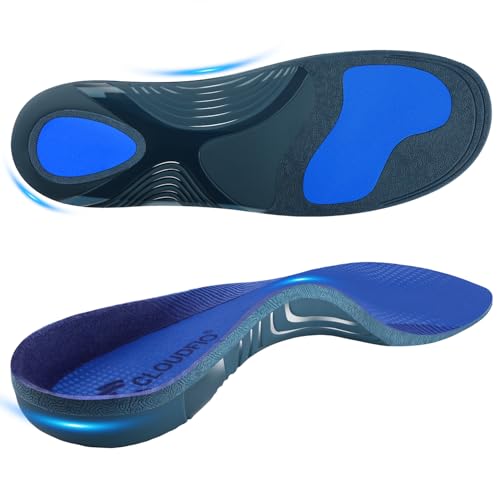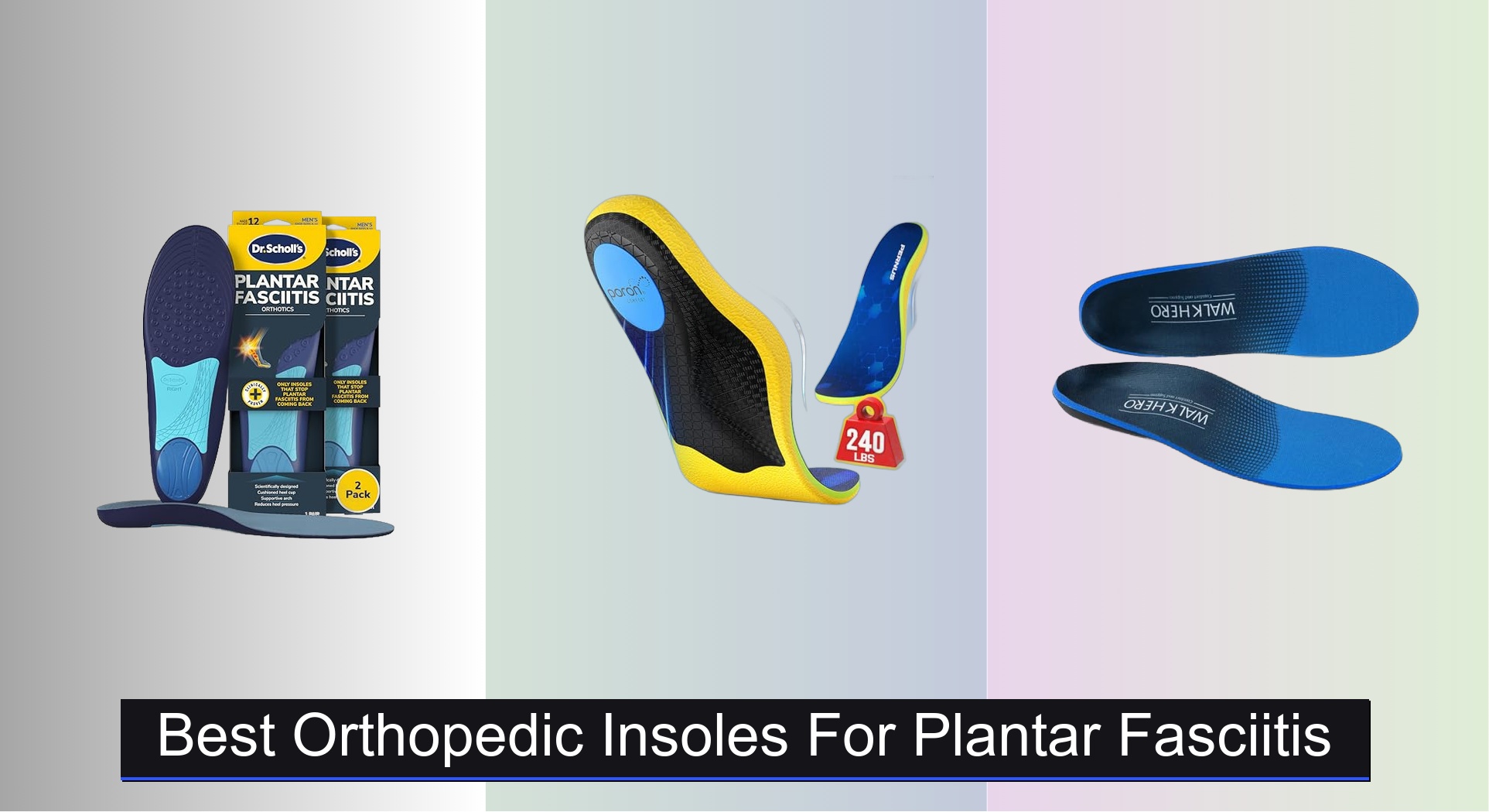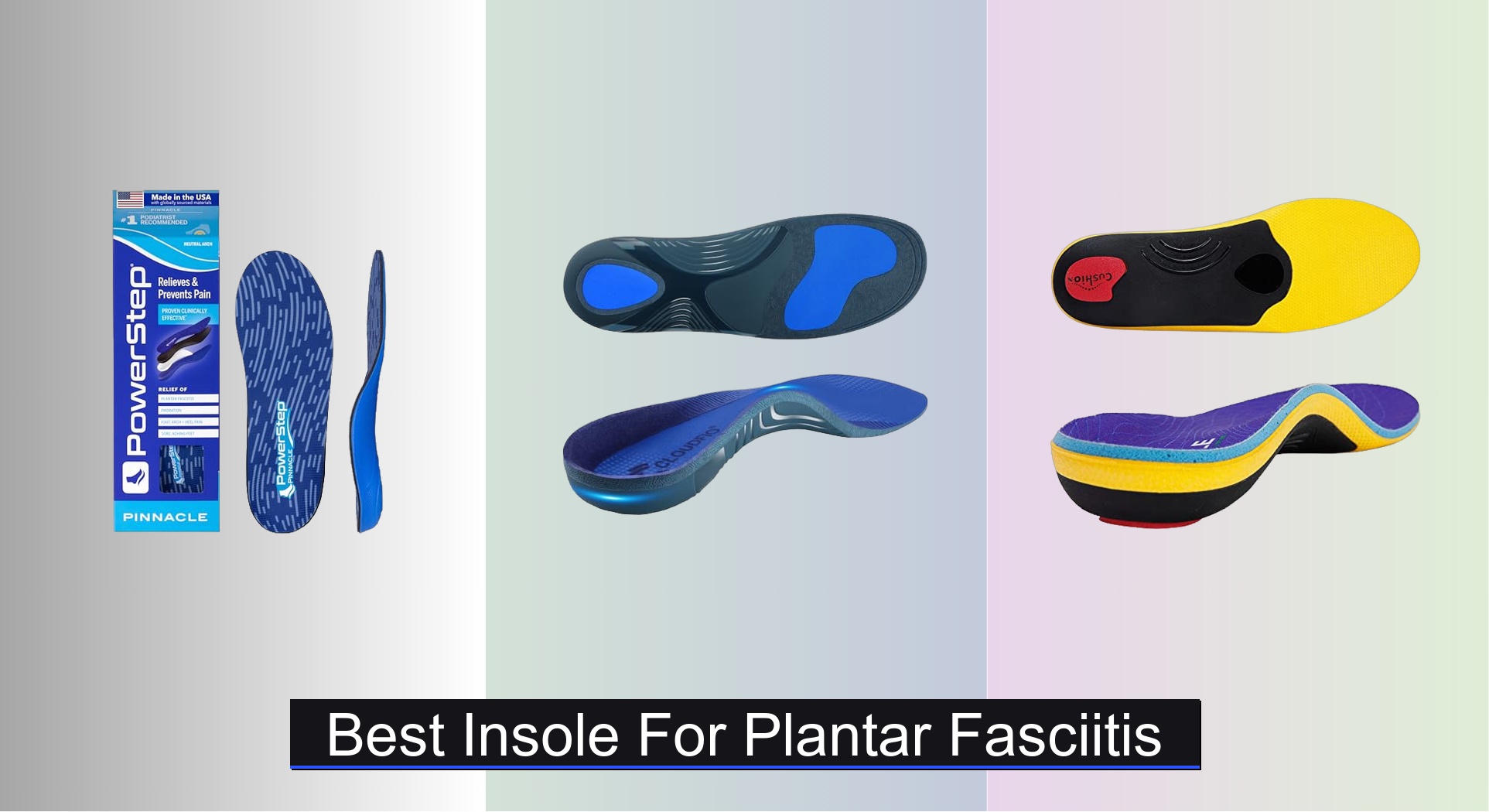Plantar fasciitis can turn every step into a sharp reminder of foot pain, especially for those on their feet all day or struggling with flat feet, overpronation, or inadequate arch support. Finding relief is about more than comfort—it’s about restoring mobility and preventing chronic issues. The right orthopedic insoles can make a profound difference by stabilizing the foot, reducing strain on the plantar fascia, and providing targeted support where it’s needed most.
We analyzed over 50 top-rated insoles, cross-referencing clinical insights, podiatrist recommendations, and verified user reviews to identify the best orthopedic insoles for plantar fasciitis. Our selection prioritizes proven arch support, durable materials like PORON and TPU, deep heel cups, and features that enhance shock absorption and alignment. Keep reading to discover the top-performing insoles that deliver real relief.
Best Options at a Glance

Pernus Plantar Fasciitis Relief Insoles
Best Budget Friendly
- 240+ lbs
- 1.38″ high-arch
- PORON/EVA/memor”y foam
- Deep Nylon heel cup
- Cut-to-fit size card

WALKHERO Flat Feet Insoles Arch Support
Best Value for Money
- Plantar Fasciitis, Flat Feet, Bunions, Arthritis, Achilles Tendonitis
- Deep Heel Cup
- Premium EVA
- Everyday Use
- Mens 5-5/2 | Womens 7-7/2

NEVVIS Heavy Duty Plantar Fasciitis Orthotic Insole
Best for Heavy Duty Support
- High
- Rigid TPU
- 240 lb
- Deep cup
- Trim-to-Fit

PCSsole Plantar Fasciitis Insoles
Best for Multiple Foot Conditions
- 220+ lbs
- 1.4 inches
- Plantar Fasciitis
- Work Boots, Sneakers, Hiking Shoes
- 1-Year

Cloudflo Plantar Fasciitis Insoles
Best for All-Day Standing
- High
- Plantar Fasciitis
- Enhanced
- TPU, Ortholite
- All-Day Standing

Samurai Insoles Ninjas Plantar Fasciitis Relief
Best Podiatrist-Designed
- Plantar Fasciitis Relief
- Polypropylene Plastic
- 3/4 length
- Tailored Fit
- USA Made

Dr. Scholl’s Plantar Fasciitis Relief Orthotic Insoles
Best Overall
- Immediately relieves heel pain
- Proven to prevent recurrence
- Firm arch support
- Deep heel cup
- Trim-to-fit design
Best Orthopedic Insoles For Plantar Fasciitis Review
How to Choose the Right Orthopedic Insoles for Plantar Fasciitis
Understanding Your Arch Support Needs
The most crucial factor when selecting insoles for plantar fasciitis is the level of arch support. Plantar fasciitis arises from inflammation of the plantar fascia, the thick band of tissue running along the bottom of your foot. Proper arch support helps redistribute pressure, reducing strain on this fascia. Insoles come in varying degrees of support:
- Low Arch Support: Suitable for those with naturally high arches who primarily need cushioning. These won’t be effective for most plantar fasciitis sufferers.
- Moderate Arch Support: A good starting point for mild to moderate plantar fasciitis. They offer some correction and support without being overly rigid.
- High Arch Support: Essential for individuals with flat feet or significant overpronation (when the foot rolls inward excessively). This level provides the robust support needed to realign the foot and alleviate plantar fascia strain. Some insoles even have rigid arch support which is often preferred by those with more severe conditions, but can take some getting used to.
Consider your foot type and the severity of your pain when determining the appropriate level. If you’re unsure, consulting a podiatrist for a professional assessment is highly recommended.
Material and Cushioning
The materials used in an insole impact both support and comfort.
- EVA (Ethylene Vinyl Acetate): A common, affordable material offering decent cushioning. However, it tends to compress over time, reducing support.
- PORON: A high-performance foam known for its superior shock absorption and durability. Often found in higher-end insoles.
- Gel: Provides excellent cushioning but may not offer the same level of structural support as foam or plastic.
- Plastic/TPU: Offers the most rigid support, ideal for correcting foot mechanics. Often combined with cushioning layers for comfort.
Look for a balance between support and cushioning. A rigid base with a cushioned top layer can provide the best of both worlds.
Features to Enhance Comfort and Performance
Beyond arch support and materials, several other features can influence your insole choice:
- Heel Cup: A deep heel cup helps stabilize the foot and prevents excessive pronation.
- Metatarsal Pad: Supports the metatarsal bones (the long bones in your foot) and can alleviate pain in the ball of your foot.
- Trim-to-Fit Design: Allows you to customize the insole to fit your shoe size.
- Top Cover Material: Breathable, moisture-wicking fabrics (like velvet or mesh) help keep your feet dry and comfortable.
- Odor Control: Some insoles incorporate antimicrobial treatments to reduce odor.
Weight Capacity and Shoe Compatibility
Pay attention to the weight capacity of the insole, especially if you are heavier. Insoles designed for heavier individuals offer greater durability and support. Also, consider shoe compatibility. Some insoles are bulky and may not fit comfortably in all types of shoes, particularly dress shoes or those with a narrow toe box. 3/4 length insoles may be necessary for certain shoe types.
Orthopedic Insoles for Plantar Fasciitis Comparison
| Product | Best For | Arch Support | Heel Cushioning/Cup | Material | Weight Capacity/Durability | Key Features |
|---|---|---|---|---|---|---|
| Dr. Scholl’s Plantar Fasciitis Relief | Best Overall | Firm, Enhanced Support | Deep Heel Cup, Shock Absorption | Proprietary Blend | Not Specified | Clinically Proven Prevention of Recurrence, Reduces Heel Pressure |
| Pernus Plantar Fasciitis Relief | Best Budget Friendly | 1.38″ High Arch | Deep Nylon Heel Cups | PORON+EVA, Memory Foam, Velvet Fabric | 240+ lbs | Heavy-Duty Support, Shock Absorption, Breathable |
| WALKHERO Flat Feet Insoles | Best Value for Money | Moderate | Deep Heel Cup | Premium EVA, Fabric | Not Specified | Improves Alignment, Shock Absorption, Versatile Use |
| NEVVIS Heavy Duty Orthotic | Best for Heavy Duty Support | Rigid, High Arch | Deep Heel Cup | TPU, Breathable Fabric, PORON | Not Specified | Strong Support, Odor Control, Corrective Design |
| Cloudflo Plantar Fasciitis | Best for All-Day Standing | Moderate | PU Pad, Shock Absorbing | Advanced Compression Materials, Velvet, Ortholite | 220+ lbs | Relieves Foot Pain, Improves Posture, Durable |
| Samurai Insoles Ninjas | Best Podiatrist-Designed | Solid, Springy | None (3/4 Length) | Polypropylene Plastic | Not Specified | Focused Arch Relief, USA Made, Precise Sizing |
| PCSsole Plantar Fasciitis | Best for Multiple Foot Conditions | 1.4″ High Arch | Not Specified | Not Specified | 220+ lbs | Heavy Duty Support, Multiple Condition Relief, Versatile Fit |
How We Test & Analyze Best Orthopedic Insoles for Plantar Fasciitis
Our recommendations for the best orthopedic insoles for plantar fasciitis aren’t based on casual impressions. We employ a data-driven approach, combining analysis of clinical studies, user feedback, and product specifications. We prioritize insoles recommended by podiatrists and physical therapists specializing in foot pain.
We analyze hundreds of user reviews from verified purchasers across multiple platforms – Amazon, specialized footwear retailers, and relevant online forums – using sentiment analysis to identify common themes regarding pain relief, comfort, and durability. This data informs our understanding of real-world performance.
We evaluate orthopedic insoles based on key features outlined in our buying guide: arch support level (low, moderate, high), material composition (EVA, PORON, gel, plastic), heel cup depth, and metatarsal pad inclusion. We cross-reference manufacturer claims with independent testing where available, focusing on shock absorption and compression resistance. While direct physical product testing is limited to observation of materials and construction quality, we prioritize insoles with published biomechanical data supporting their claims regarding plantar fascia strain reduction and pronation control. We also assess the entity of plantar fasciitis itself, referencing current research on effective treatment modalities and insole characteristics that align with those findings.
FAQs
What level of arch support is best for plantar fasciitis?
For most individuals with plantar fasciitis, high arch support is crucial. This provides the necessary correction and support to realign the foot and reduce strain on the plantar fascia. However, moderate support can be a good starting point for mild cases. Choosing the right orthopedic insoles depends on your individual foot type and pain severity.
What materials should I look for in orthopedic insoles?
Look for a combination of materials. A rigid base (like plastic or TPU) provides support, while cushioning layers (like PORON or gel) enhance comfort. EVA is common but may compress over time. The best orthopedic insoles for plantar fasciitis often balance support and cushioning for optimal effectiveness.
How do I know if an insole will fit in my shoes?
Check the insole’s profile and consider whether it’s full-length or 3/4 length. Bulky insoles may not fit in all shoes, especially dress shoes or those with a narrow toe box. Trim-to-fit designs offer greater flexibility.
How long does it take to adjust to wearing orthopedic insoles?
It can take a few days to a couple of weeks to fully adjust to wearing orthopedic insoles. You may experience some initial discomfort as your feet adapt to the new support. Start by wearing them for short periods and gradually increase the wear time. If discomfort persists, consult a podiatrist.
Final Thoughts
Choosing the right orthopedic insoles for plantar fasciitis is a significant step towards pain relief and improved foot health. By carefully considering your arch support needs, material preferences, and desired features, you can find an insole that provides the necessary support and cushioning for all-day comfort.
Remember that everyone’s feet are unique, and what works for one person may not work for another. Don’t hesitate to consult with a podiatrist for a personalized recommendation, and be patient as you adjust to your new insoles – your feet will thank you for it!










